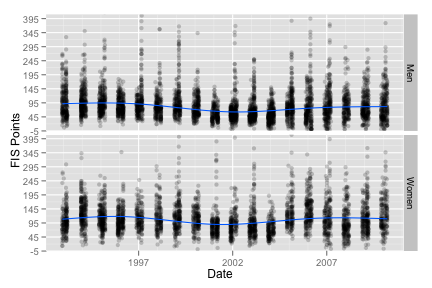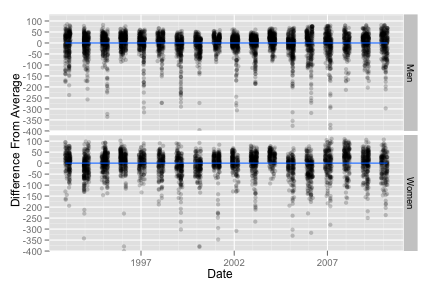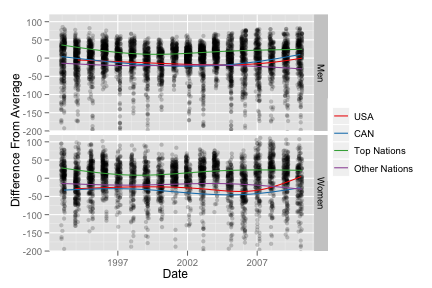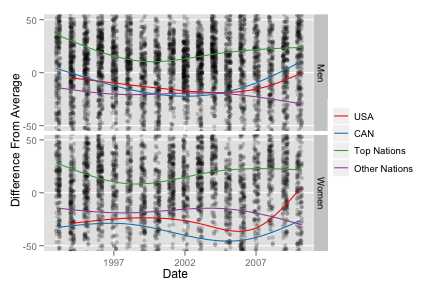In a previous post, I talked about rookie skier performance on the World Cup. Â You can check back there for an explanation of what I mean by a rookie skier and the specifics of how I selected which data to use. Â I left off in that post with the following graph, showing rookie FIS point results over time:

I mentioned some curious aspects of this graph, notably the fluctuations in the presence of extremely fast rookie skiers over time. Â Also, the general fluctuations in rookie performances over time will make it difficult to compare subgroups, as these comparisons may be confounded by the overall trends shown above.
The obvious solution is to simply remove these global trends and rescale the data. Â What this means is that I’m going to subtract the blue lines in the above graph from each data point. Â The result is shown below:

Now what we have is the same set of points, but plotted relative to the trends in the first graph. Â Notice the overall trend is essentially flat. Â The position of each point now reflects it’s position relative to a “typical” rookie performance at that point in time. Â Above the blue line is better than average, below is worse. Â This way, comparisons between groups of nations will be a bit fairer.
Now all we need to do is add trend lines for our four groups: USA, CAN, Top Nations and Other Nations:

Notice that rookies from the Top Nations (NOR, SWE, FIN, ITA, GER, RUS) have maintained a 25-50 FIS point advantage of the USA and CAN, at least until recently. Â Let’s get a closer look by zooming in on this graph a bit for a better view:

Here we can see a bit more clearly that rookie performances by Canadian men have improved dramatically over the last five years or so. Â Rookie performances by American men have improved as well, though not quite as dramatically. Â Recall that zero in this graph represents the “average” rookie performance across every skier, so the rookie Canadian men have just pushed above average and the rookie American men have just clawed their way back to that level.
The Canadian and American women rookies appear to have traditionally lagged a bit further behind, but both have also been improving recently. Â This time, though it’s the American women who are improving faster than the Canadians. Â Rookie American female performances appear to have climbed back up to around average, while the Canadian rookies are still a bit behind.
Finally, we can look at separate plots for each group to get a sense for the number of data points (rookie races) in each group:

One thing I like about this view of the data is that it shows us that there have been times with very few new athletes appearing on the World Cup scene from the USA and CAN.  Having regular World Cup races in North America (and two Olympics!) over the past decade has helped enormously.
[ad#AdSenseBanner]
Post a Comment